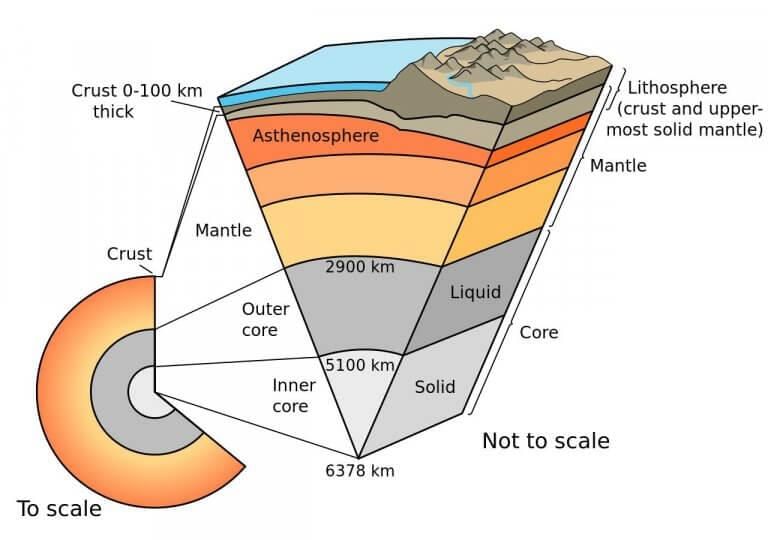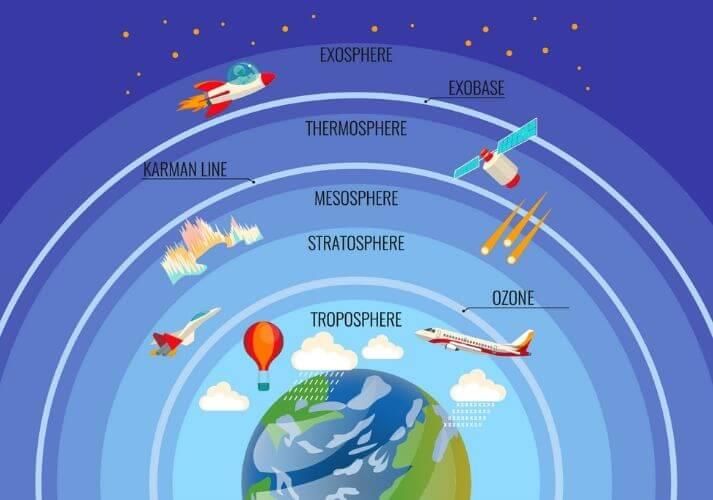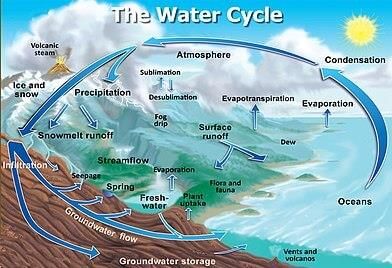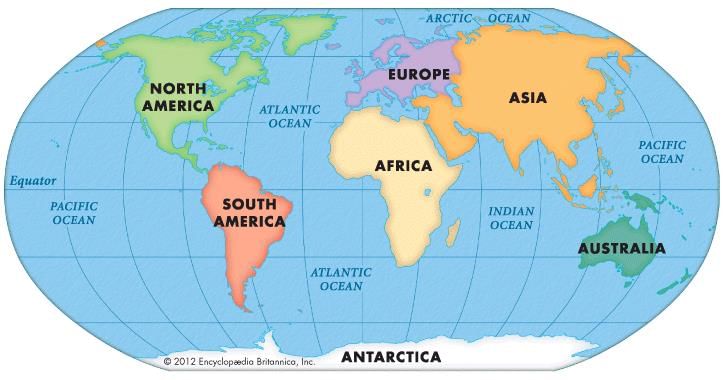UPSC Exam > UPSC Notes > Geography for UPSC CSE > Domains of the Earth
Domains of the Earth | Geography for UPSC CSE PDF Download
| Table of contents |

|
| Domains of the Earth: Lithosphere, Atmosphere, Hydrosphere, Biosphere |

|
| Atmosphere |

|
| Hydrosphere |

|
| Oceans |

|
| Biosphere – The Domain of Life |

|
Domains of the Earth: Lithosphere, Atmosphere, Hydrosphere, Biosphere
Major domains of the earth are a basic concept in Geography. The earth’s surface is a complex zone in which the three major components of the environment meet, overlap and interact.
The Four Domains of the Earth
- Lithosphere: The solid portion of the earth
- Atmosphere: The gaseous layers that surround the earth
- Hydrosphere: Water covers a very big area of the earth’s surface, and this area is called the Hydrosphere
- Biosphere: It is the narrow zone where land, water, and air together are found.
Lithosphere
The solid portion of the earth on which we live
- Comprises the rocks of the earth’s crust and the thin layers of soil that contains nutrient elements which sustain organisms
- Continents- large landmasses
- Ocean basins- the huge water bodies

Question for Domains of the EarthTry yourself:What is the thickness of the Outer Core?
View Solution
Continents
There are seven major continents, and these are separated by large water bodies.
- Asia
- Asia is the largest continent covering one-third of the total land area of the earth.
- The continent lies in the Eastern Hemisphere.
- The Tropic of Cancer passes through Asia.
- The Ural Mountains on the west separates from Europe.
- Europe
- Europe is much smaller than Asia lying to the west of Asia.
- The Arctic Circle passes through it.
- Its three sides are bound by water bodies.
- Africa
- Africa is the second-largest continent after Asia.
- A large part of Africa lies in the Northern Hemisphere.
- Africa is the only continent through which the Tropic of Cancer, the Equator and the Tropic of Capricorn pass.
- North America
- North America is the third largest continent in the world.
- The continent lies completely in the Northern and Western Hemisphere.
- The Isthmus of Panama a narrow strip links North America and South America.
- This continent is surrounded by three oceans, and they are the Atlantic Ocean, the Pacific Ocean, and the Arctic Ocean.
- South America
- South America lies mostly in the Southern Hemisphere.
- It is surrounded by two oceans; the Pacific Ocean on the west and the Atlantic Ocean on the east and north.
- Australia
- Australia is the smallest continent that lies entirely in the Southern Hemisphere.
- It is surrounded on all sides by the oceans and seas.
- It is called an island continent.
- Antarctica
- Antarctica is a huge continent and lies completely in the Southern Hemisphere.
- The South Pole lies in the South Polar Region almost at the centre of this continent and is permanently covered with thick ice sheets.
Atmosphere
The gaseous layers that surround the earth— where oxygen, nitrogen, carbon dioxide and other gases are found and interact
- Provides the air we breathe + Protects us from the harmful effects of sun’s rays.
- The changes in the atmosphere produce changes in the weather and climate.
- Extends up to a height of about 1,600 kilometres
- The gravitational force of the earth holds the atmosphere around it
- Divided into five layers based on composition, temperature and other properties— troposphere, the stratosphere, the mesosphere, the thermosphere and the exosphere.
- Composed mainly of—
(i) Nitrogen and oxygen, which make up about 99 per cent of clean, dry air.
(ii) Nitrogen (helps in the growth of living organisms) 78 per cent, oxygen 21 per cent and other gases like carbon dioxide, argon and others comprise 1 per cent by volume
(iii) Carbon dioxide: Present in minute amount but is important as it absorbs heat radiated by the earth, thereby keeping the planet warm and also essential for the growth of plants. - The density of the atmosphere: Maximum at the sea level and decreases rapidly as we go up
- Wind: Moves from high pressure to low pressure

Hydrosphere
- The earth is called the blue planet.
- More than 71 per cent of the earth is covered with water, and 29 per cent is with the land. Hydrosphere consists of water in all its forms.
- More than 97% of the Earth’s water is found in the oceans and is too salty for human use.
- Hydrosphere consists of water in all its forms like running water in oceans and rivers and in lakes, ice in glaciers, underground water and the water vapour in the atmosphere.
- 97% of the Earth’s water is found in the oceans and is too salty, the rest of the water is in the form of ice sheets and glaciers or under the ground, and a very a small percentage is available as fresh water for human use

Question for Domains of the EarthTry yourself:Which of the following statements is incorrect?
View Solution
Oceans
- The three chief movements of ocean waters are the waves, the tides and the ocean currents.
- Oceans are the major part of the hydrosphere, and they are all interconnected.
- The five major oceans in order of their size are
(i) the Pacific Ocean: It is almost circular in shape. Asia, Australia, North and South Americas surround it.
(ii) the Atlantic Ocean: It is the second-largest ocean in the world. It is ‘S’ shaped. It is flanked by the North and South Americas on the western side, and Europe and Africa on the eastern side.
(iii) the Indian Ocean: It is the only ocean named after a country, that is, India. The shape of the ocean is almost triangular. In the north, it is bound by Asia, in the west by Africa and in the east by Australia.
(iv) the Southern Ocean: It surrounds the continent of Antarctica
(v) the Arctic Ocean: It is located within the Arctic Circle and surrounds the North Pole. The Barring strait a narrow stretch of shallow water, connects it with the Pacific Ocean.

Biosphere – The Domain of Life
- The biosphere is the narrow zone of contact between the land, water and air.
- It is the zone where life exists that makes this planet unique.
- The organisms in the biosphere are commonly divided into:
(i) the plant kingdom
(ii) the animal kingdom - The three domains of the earth interact with each other and affect each other in some way or the other.

The document Domains of the Earth | Geography for UPSC CSE is a part of the UPSC Course Geography for UPSC CSE.
All you need of UPSC at this link: UPSC
|
175 videos|624 docs|192 tests
|
FAQs on Domains of the Earth - Geography for UPSC CSE
| 1. What is the lithosphere? |  |
Ans. The lithosphere is the solid outer layer of the Earth, consisting of the crust and the uppermost part of the mantle. It is divided into several tectonic plates that constantly move and interact with each other.
| 2. How does the atmosphere contribute to the Earth's climate? |  |
Ans. The atmosphere plays a crucial role in regulating the Earth's climate. It acts as a protective layer, trapping heat from the Sun and preventing it from escaping into space. It also contains greenhouse gases, such as carbon dioxide, which help to maintain the Earth's temperature by trapping some of the heat radiated from the surface.
| 3. What is the hydrosphere and its importance? |  |
Ans. The hydrosphere refers to all the water on Earth, including oceans, lakes, rivers, groundwater, and even water vapor in the atmosphere. It is vital for supporting life and plays a key role in various Earth processes, such as the water cycle, climate regulation, and transportation of nutrients.
| 4. How are oceans part of the hydrosphere? |  |
Ans. Oceans are a significant component of the hydrosphere. They cover about 71% of the Earth's surface and contain about 97% of the planet's water. Oceans play a crucial role in regulating climate, providing habitats for numerous marine species, and influencing weather patterns through the exchange of heat and moisture with the atmosphere.
| 5. What is the biosphere and its relationship with the other domains? |  |
Ans. The biosphere refers to all living organisms on Earth and their interactions with the other domains. It encompasses all ecosystems, including forests, deserts, oceans, and even areas deep underground. The biosphere relies on the lithosphere, atmosphere, and hydrosphere for resources and environmental conditions necessary for life to thrive.
Related Searches
















